Toshiba KIRAbook Ultrabook Review
by Dustin Sklavos on May 9, 2013 12:01 AM ESTDisplay Quality
The Toshiba KIRAbook's claim to fame is its 2560x1440 13.3" IPS display, and that display really is a beauty. Viewing angles are excellent as one would expect, but there are two very minor issues. First, response time is good, but not great, and there's minor ghosting when dragging a window or the start screen. There's also backlight bleed on the edges of the display that's fairly typical of an edge-lit panel. Neither of these are dealbreakers and I'd still very easily take the KIRAbook's display over just about any competing notebook's, including the 1080p IPS stunner in the Dell XPS 13.
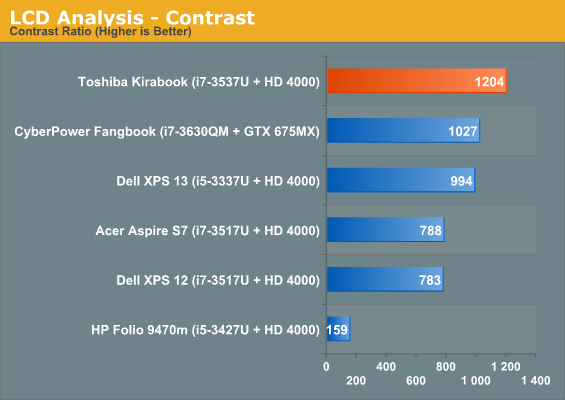
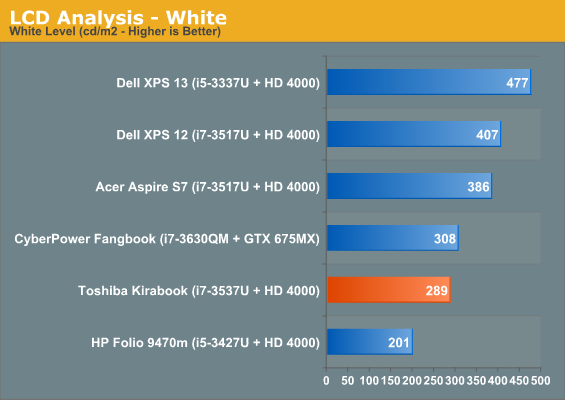
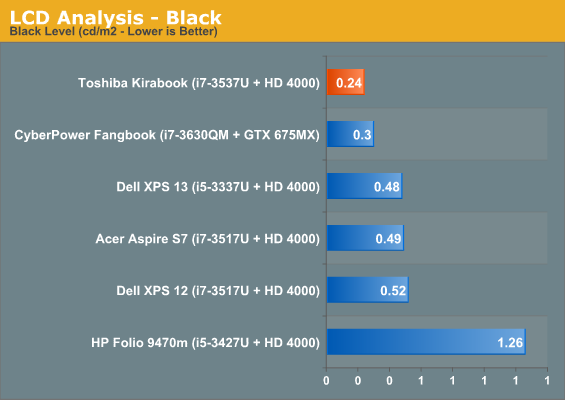
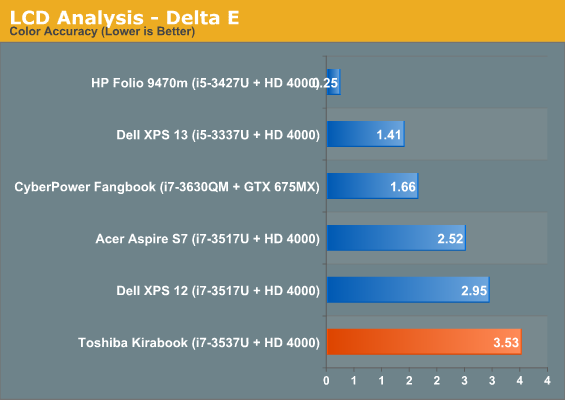
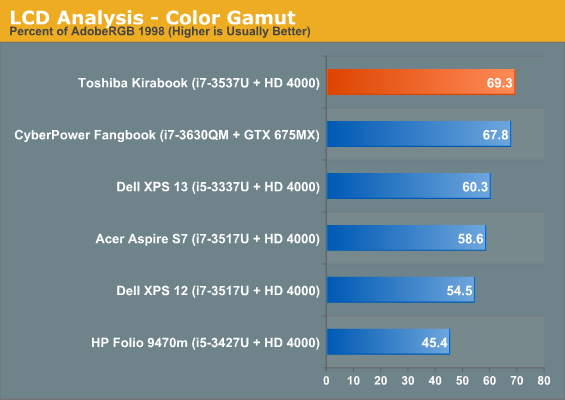
Everything about the KIRAbook's display screams quality except the measured delta-E, but in practice I found the display color to be plenty accurate and certainly worthy of the packed-in Adobe Photoshop Elements. Color gamut's quite good, brightness is beautiful without being excessive, and black levels are stellar. It's difficult not to be impressed with this panel.
Battery Life
When dealing with a high-resolution IPS panel, especially one as bright as the KIRAbook's, it can be hard to predict just how the battery life will play out. That's compounded by the fact that space for battery cells inside an ultrabook is always at a premium. The 52Wh integrated battery is at least slightly above average, though.
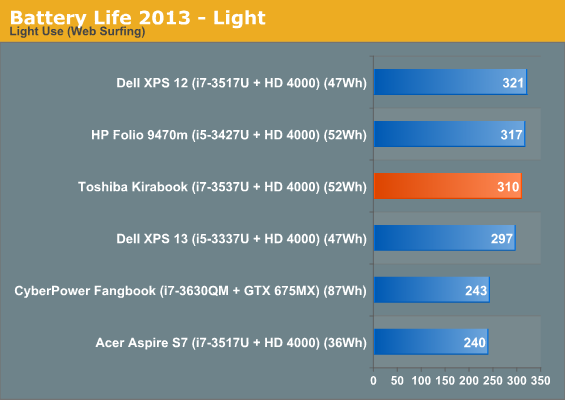
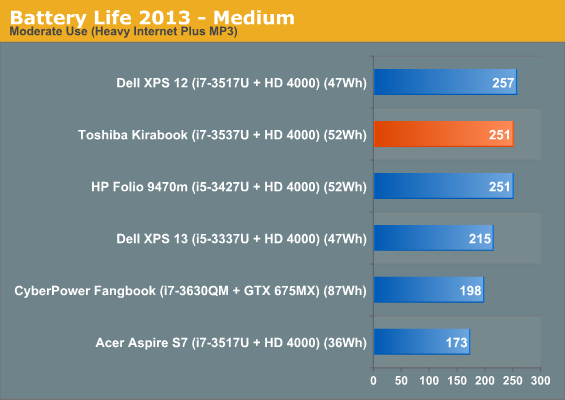
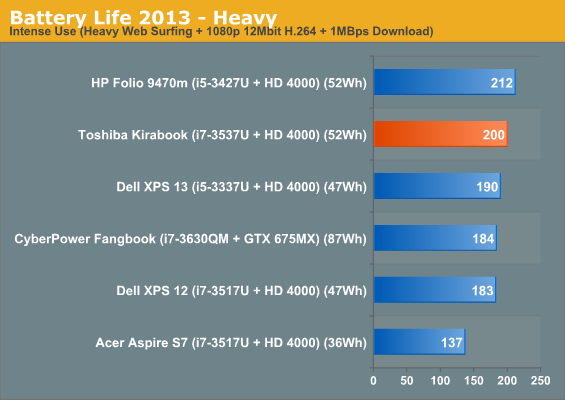
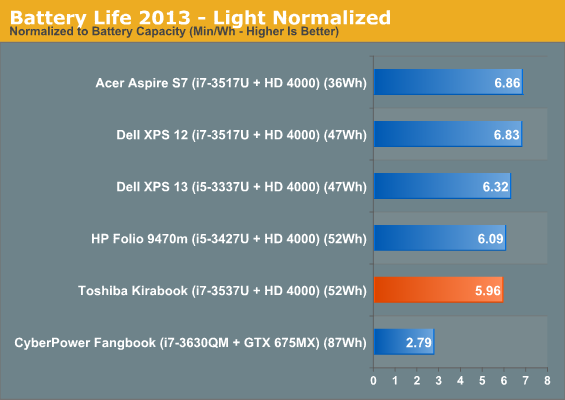
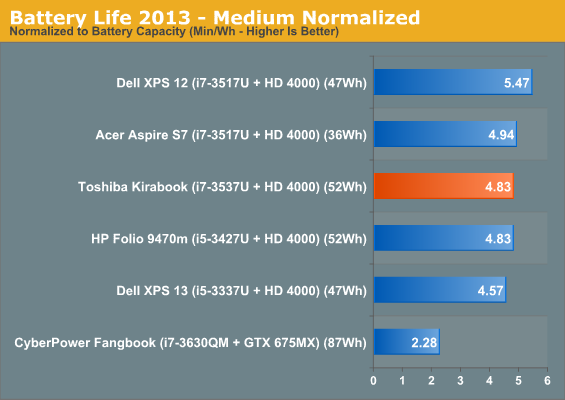
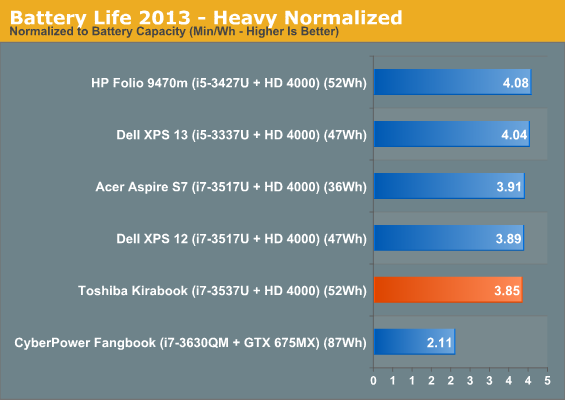
In broader terms, the KIRAbook produces battery life competitive with other ultrabooks in its class. When you normalize it, things look slightly worse, but not substantially so. There's clearly a very minor trade-off taking place to get that better display quality. That trade-off is largely negated by the slightly larger battery and substantially superior panel.
Heat and Noise
Toshiba made a big deal about the KIRAbook's cooling mechanism, but in practice this cooling system is essentially identical to the one in the Portege Z835. That worked out great for the Portege when we reviewed it, which featured a turbo-free Sandy Bridge low-voltage Core i3, but the KIRAbook has a harder time dealing with the horsepower of the i7-3537U.
Thermals under load are quite good, but noise is much less so. Idle noise is stellar; the KIRAbook is basically inaudible. Sustained load hitting the CPU causes the fan to spin up gradually, and again I lament the bottom-intake fan. During Cinebench R11.5 testing the i7-3537U spent most of its time at 2.3GHz, and it did take a good minute or so before noise the fan started spinning up, and a low narrow whooshing was eventually accompanied by a slight whine. Thankfully surface temperatures never got uncomfortable, though I'd recommend against touching the area near the hinge on the inside of the notebook.
A far as cooling systems go, this isn't necessarily a bad one, but I'd almost give up some of the ports on one side of the KIRAbook just to get side-oriented cooling. The Acer Aspire V5-171 I reviewed was a budget notebook just a touch too fat to get the ultrabook branding (to say nothing of the dismal stock hard drive), but that extra girth also allowed it to integrate a vastly superior cooling system that made it much more practical in the long run.


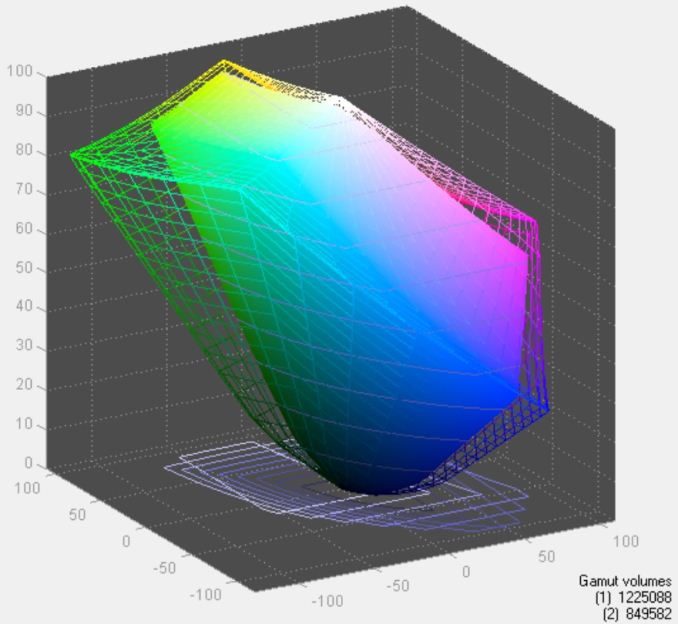
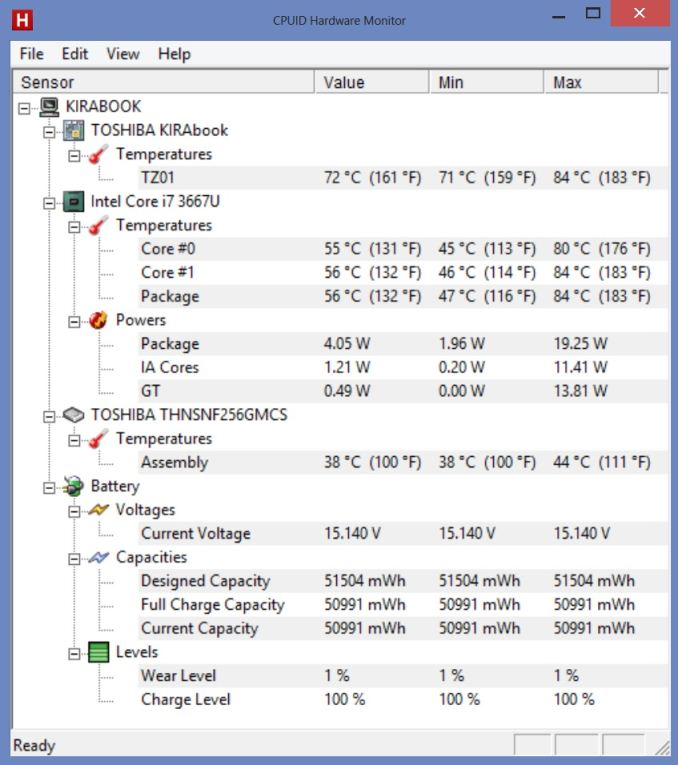








110 Comments
View All Comments
wanderer000 - Sunday, May 26, 2013 - link
Why does a laptop need to have things hanging out of it to achieve 5Ghz? It's all internal.......wanderer000 - Sunday, May 26, 2013 - link
Whoops just ignore me, your comment confused me on first read.madmilk - Saturday, May 11, 2013 - link
They're not the one manufacturer that finally made a laptop with a good screen. They're the second, following Apple, and in any case being first doesn't mean no other standards apply. For comparison: the $1500 rMBP comes with a dual-band, 3x3 802.11n adapter, and that really should be the norm for a laptop of that price.Dalamar6 - Monday, May 13, 2013 - link
They aren't the 2nd to use a "good screen" by far. They're the second to use one this good that's higher res than 1920x1200.In any case, I do not see the point to using such a high res screen on less than a 20" notebook, or at the very least, 17". 1080p pixel pitch is TINY on 15.6" already.
I wouldn't buy this... that much money's better spent on an IPS screen laptop elsewhere.
ShieTar - Tuesday, May 14, 2013 - link
Actually, the tiny resolution does make sense, because it makes texts and other fine details more readable if the software offers reasonable scaling. Which any office suite, web browser and a lot of other productive stuff do.When you view videos or play games, resolution becomes less relevant. Nevertheless, if the HD4000 is too weak to play the full resolution, it is nice to be able to use half resolution without major resampling artifacts. That actually works fine with the 1440p screen scaled to 720p, which is a design resolution for most modern games anyways, but you won't be able to scale anything modern to 960x540 and still enjoy it.
Alternatively, you can try to play the full resolution an just switch of any kind of AA, as you basically get a biological AA due to the sub-visible pixel size.
wanderer000 - Sunday, May 26, 2013 - link
It is when it costs an arm and a leg.JoseAntinio - Friday, May 10, 2013 - link
Hi I'm new here and would appreciate some advice.My understanding is that 2.4GHz Vs 5GHz have both plus and minuses and many believe that 2.4GHz is a better option for the home user.
If I am right there are no speed issues, in fact as I understand it 2.4GHz can run quicker.
Could it be that Toshiba have actually got it right for the target market?
hp79 - Friday, May 10, 2013 - link
Yup, both plus and minus. I use both at home. 2.4GHz is too crowded these days especially if you live in an apartment. That's when 5GHz does a great job.Wifi cards generally support only 2.4GHz, or both 2.4GHz&5GHz. It's very rare to find a card that only supports 5GHz. If you look at prices on ebay, intel 6300 wifi cards costs about $20 while the cheaper models costs about $15. There's not really that much price difference, so it's just crazy not to put a proper wifi card in a flagship device.
My Galaxy Note1 also supports both 2 and 5GHz band, and my HTC One even supports 801.11ac (max 450mbps, 5GHz band). Toshiba should have put a card that supports 801.11ac since nothing is replaceable.
CSMR - Sunday, May 12, 2013 - link
Very few people will even know what this means, let alone notice the difference. Ultrabooks have clear compromises (e.g. 256GB total storage); this is an extremely minor point in comparison. Any wireless internet, regardless the speed or standard, will fill up 256GB in no time.jeffkibuule - Saturday, May 18, 2013 - link
Umm... the problem with 2.4Ghz is that in an apartment complex that has 25 wireless networks around it, using that spectrum is bound to cause interference when there are only 3 non-overlapping transmit channels. That manifests itself in dropped packets. It has nothing to do with downloading data off the Internet.